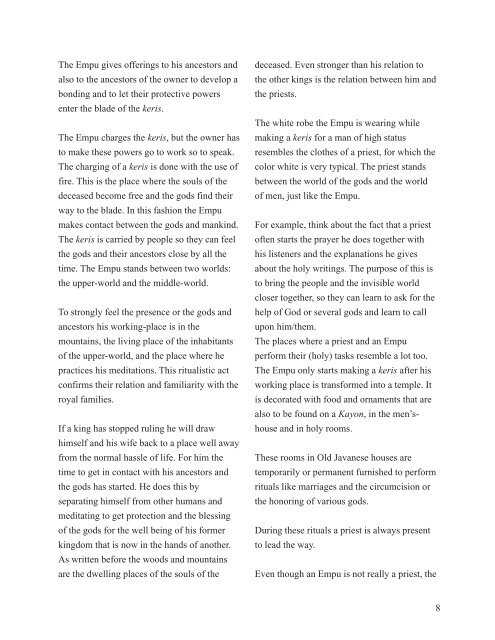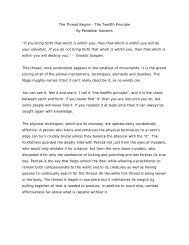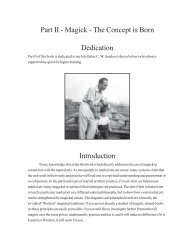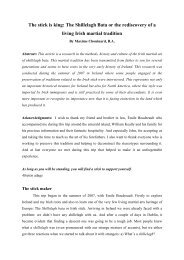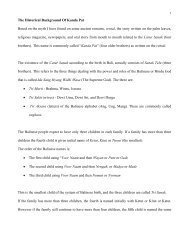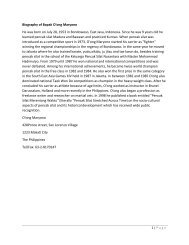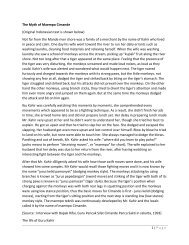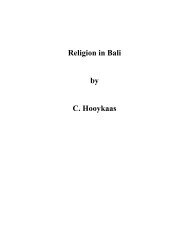Tenaga Dalam - Pukulan Cimande Pusaka
Tenaga Dalam - Pukulan Cimande Pusaka
Tenaga Dalam - Pukulan Cimande Pusaka
Create successful ePaper yourself
Turn your PDF publications into a flip-book with our unique Google optimized e-Paper software.
The Empu gives offerings to his ancestors and<br />
also to the ancestors of the owner to develop a<br />
bonding and to let their protective powers<br />
enter the blade of the keris.<br />
The Empu charges the keris, but the owner has<br />
to make these powers go to work so to speak.<br />
The charging of a keris is done with the use of<br />
fire. This is the place where the souls of the<br />
deceased become free and the gods find their<br />
way to the blade. In this fashion the Empu<br />
makes contact between the gods and mankind.<br />
The keris is carried by people so they can feel<br />
the gods and their ancestors close by all the<br />
time. The Empu stands between two worlds:<br />
the upper-world and the middle-world.<br />
To strongly feel the presence or the gods and<br />
ancestors his working-place is in the<br />
mountains, the living place of the inhabitants<br />
of the upper-world, and the place where he<br />
practices his meditations. This ritualistic act<br />
confirms their relation and familiarity with the<br />
royal families.<br />
If a king has stopped ruling he will draw<br />
himself and his wife back to a place well away<br />
from the normal hassle of life. For him the<br />
time to get in contact with his ancestors and<br />
the gods has started. He does this by<br />
separating himself from other humans and<br />
meditating to get protection and the blessing<br />
of the gods for the well being of his former<br />
kingdom that is now in the hands of another.<br />
As written before the woods and mountains<br />
are the dwelling places of the souls of the<br />
deceased. Even stronger than his relation to<br />
the other kings is the relation between him and<br />
the priests.<br />
The white robe the Empu is wearing while<br />
making a keris for a man of high status<br />
resembles the clothes of a priest, for which the<br />
color white is very typical. The priest stands<br />
between the world of the gods and the world<br />
of men, just like the Empu.<br />
For example, think about the fact that a priest<br />
often starts the prayer he does together with<br />
his listeners and the explanations he gives<br />
about the holy writings. The purpose of this is<br />
to bring the people and the invisible world<br />
closer together, so they can learn to ask for the<br />
help of God or several gods and learn to call<br />
upon him/them.<br />
The places where a priest and an Empu<br />
perform their (holy) tasks resemble a lot too.<br />
The Empu only starts making a keris after his<br />
working place is transformed into a temple. It<br />
is decorated with food and ornaments that are<br />
also to be found on a Kayon, in the men’shouse<br />
and in holy rooms.<br />
These rooms in Old Javanese houses are<br />
temporarily or permanent furnished to perform<br />
rituals like marriages and the circumcision or<br />
the honoring of various gods.<br />
During these rituals a priest is always present<br />
to lead the way.<br />
Even though an Empu is not really a priest, the<br />
8


